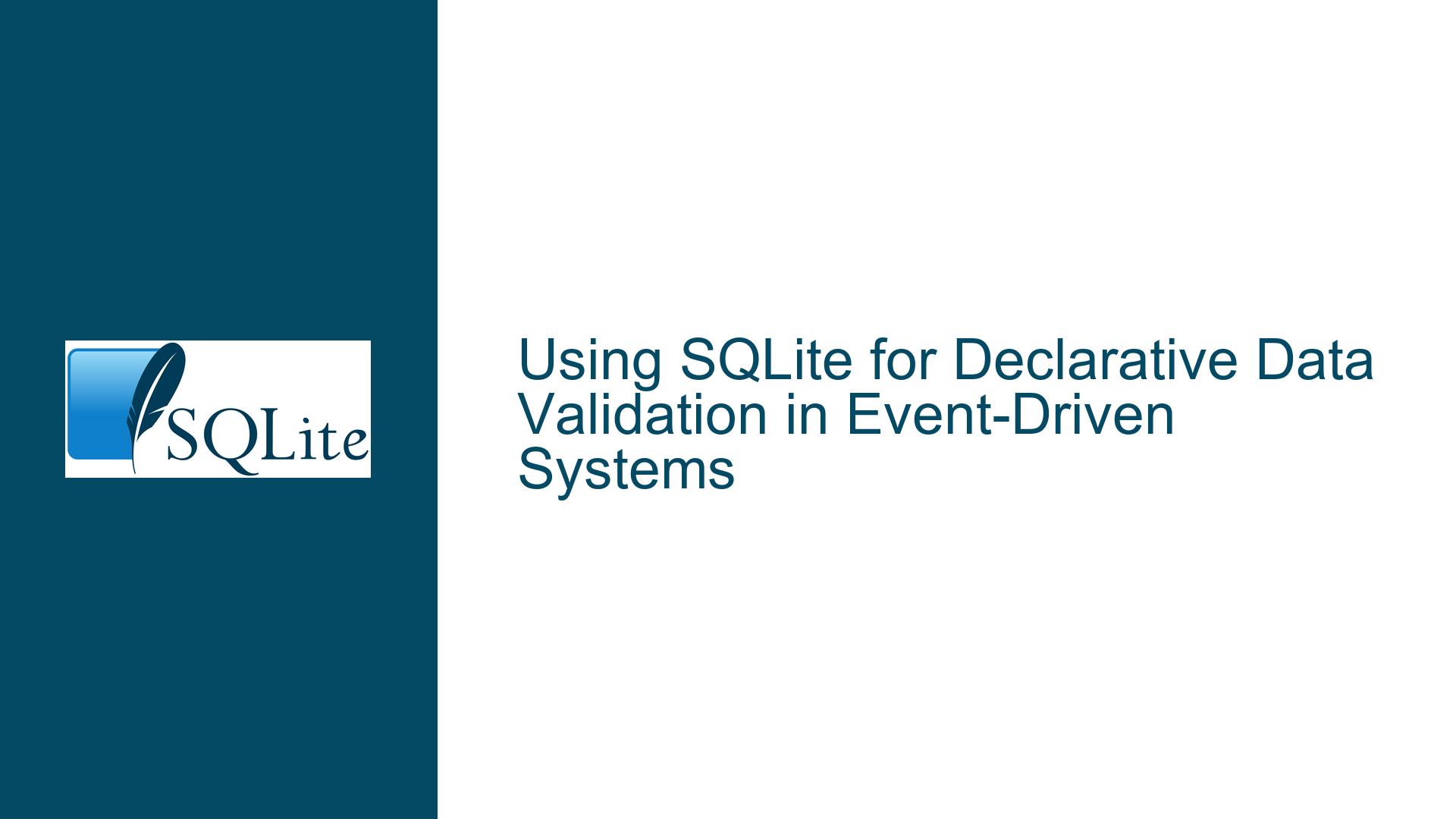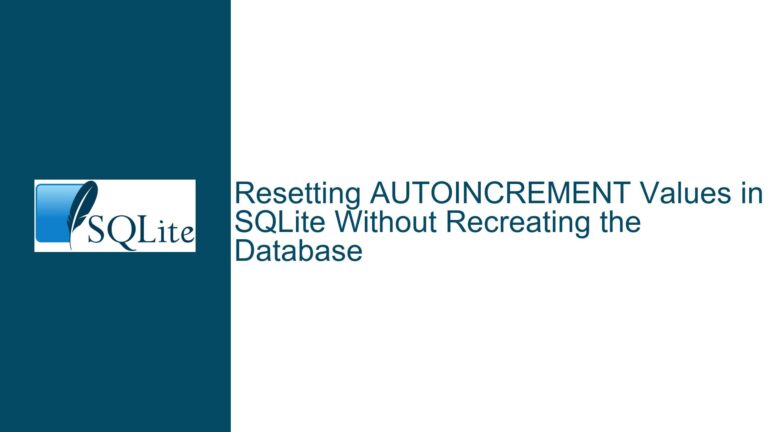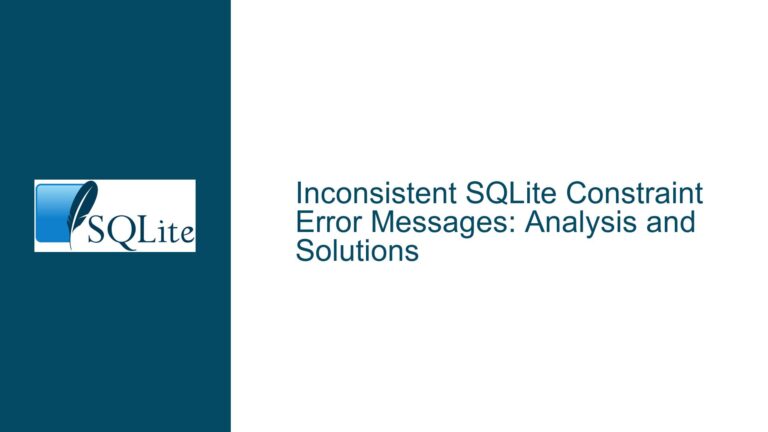Using SQLite for Declarative Data Validation in Event-Driven Systems
Issue Overview: SQLite as a Declarative Data Validator in Event-Driven Systems
In event-driven systems, particularly those involving modal dialogs, there is often a need to validate user input against a set of constraints. The challenge lies in creating a system that allows users to define these constraints declaratively, without requiring them to write extensive code. SQLite has been proposed as a potential solution for this problem due to its expressive SQL syntax, dynamic execution capabilities, and robust support for predicate logic. However, the approach of using SQLite as a data validator introduces several complexities, particularly around schema design, constraint enforcement, and data model integration.
The core idea is to allow users to define a database schema that includes their validation constraints. The system would then execute this schema, attempt to insert a row into the database, and mark the data as valid if the insertion succeeds. If the insertion fails due to constraint violations, the data would be marked as invalid. After validation, the database would be deleted to ensure no residual data remains. While this approach seems straightforward, it raises several questions about the feasibility and efficiency of using SQLite in this manner.
One of the primary concerns is the limitation of SQLite’s CHECK constraints, which can only operate on the current row and cannot reference other tables or rows. This limitation makes it difficult to enforce complex, cross-row, or cross-table constraints. Additionally, SQLite does not support the ALTER TABLE ADD CHECK CONSTRAINT command, which means that constraints must be defined at the time of table creation. This restriction complicates the process of dynamically adding or modifying constraints based on user input.
To address these limitations, two alternative approaches have been proposed: using triggers and Quality Control (QC) views. Triggers can be used to enforce constraints that go beyond the capabilities of CHECK constraints, but they introduce additional complexity and potential performance overhead. QC views, on the other hand, are specialized views that compute anomalies and report violations as rows. These views can access arbitrary tables and provide detailed explanations for constraint violations, making them a powerful tool for data validation.
Possible Causes: Limitations and Challenges in SQLite-Based Data Validation
The challenges of using SQLite as a declarative data validator stem from several inherent limitations and design considerations. Understanding these limitations is crucial for identifying the root causes of potential issues and developing effective solutions.
1. SQLite’s Constraint Enforcement Limitations: SQLite’s CHECK constraints are limited in scope and functionality. They can only operate on the current row being inserted or updated, which makes it impossible to enforce constraints that involve multiple rows or tables. For example, if a constraint requires comparing the value of a column in one table with the value of a column in another table, CHECK constraints alone cannot achieve this. This limitation necessitates the use of additional mechanisms, such as triggers or QC views, to enforce more complex constraints.
2. Lack of Dynamic Constraint Modification: SQLite does not support the dynamic addition or modification of CHECK constraints after a table has been created. This means that all constraints must be defined at the time of table creation, which can be restrictive in scenarios where constraints need to be added or modified based on user input or changing requirements. While it is possible to create a new table with the desired constraints and migrate data from the old table, this approach can be cumbersome and inefficient, especially for large datasets.
3. Performance Overhead of Triggers: Triggers can be used to enforce constraints that go beyond the capabilities of CHECK constraints, but they introduce additional complexity and potential performance overhead. Triggers are executed automatically in response to specific events, such as INSERT, UPDATE, or DELETE operations, and they can perform arbitrary SQL operations. While this flexibility is powerful, it can also lead to performance issues if triggers are not carefully designed and optimized. For example, a trigger that performs complex calculations or accesses multiple tables can significantly slow down data insertion or modification operations.
4. Complexity of QC Views: QC views are a powerful tool for data validation, but they require careful design and implementation. These views must be designed to compute anomalies and report violations as rows, which can be challenging for users who are not familiar with SQL or database design. Additionally, QC views must be integrated into the overall data validation process, which involves checking for rows in these views after data insertion or modification. This integration adds another layer of complexity to the system and requires careful coordination between the application and the database.
5. Data Model Integration: The proposed approach involves creating a database schema that includes user-defined constraints, executing the schema, and attempting to insert a row into the database. This process requires tight integration between the application and the database, as the application must dynamically generate and execute SQL statements based on user input. This integration can be challenging, especially in a Go-based environment where users may be uncomfortable with writing code. Additionally, the process of creating and deleting databases for each validation operation can introduce performance and resource management issues, particularly in high-throughput systems.
Troubleshooting Steps, Solutions & Fixes: Implementing SQLite-Based Data Validation
To address the challenges and limitations of using SQLite as a declarative data validator, the following steps, solutions, and fixes can be implemented:
1. Leveraging Triggers for Complex Constraints: Triggers can be used to enforce constraints that go beyond the capabilities of CHECK constraints. For example, a trigger can be created to enforce a constraint that compares the value of a column in one table with the value of a column in another table. The trigger can be designed to raise an error or log a violation if the constraint is not satisfied. While triggers introduce additional complexity, they provide a powerful mechanism for enforcing complex constraints. To minimize performance overhead, triggers should be carefully designed and optimized, and their execution should be limited to only those operations that require constraint enforcement.
2. Implementing QC Views for Anomaly Detection: QC views can be used to detect and report constraint violations as rows. These views should be designed to compute anomalies based on user-defined constraints and return rows that represent violations. For example, a QC view could be created to check for duplicate entries in a table or to ensure that a value in one table falls within a specified range of values in another table. The application can then check for rows in these views after data insertion or modification and use the results to determine whether the data is valid. To simplify the implementation of QC views, a naming convention can be used to identify views that are used for quality control (e.g., views with names that start with qc$).
3. Dynamic Schema Generation and Execution: To support dynamic constraint modification, the application can generate and execute SQL statements to create or modify tables based on user input. This approach involves creating a new table with the desired constraints and migrating data from the old table. While this process can be cumbersome, it provides a way to dynamically add or modify constraints without requiring users to write code. To improve efficiency, the application can use transactions to ensure that schema modifications are atomic and to minimize the impact on performance.
4. Optimizing Performance and Resource Management: The process of creating and deleting databases for each validation operation can introduce performance and resource management issues. To address these issues, the application can use in-memory databases or connection pooling to reduce the overhead of database creation and deletion. Additionally, the application can optimize the execution of SQL statements by using prepared statements and batching operations. These optimizations can help to minimize the impact on performance and ensure that the system can handle high-throughput validation operations.
5. Providing User-Friendly Interfaces and Documentation: To make the system more accessible to users who are uncomfortable with writing code, the application should provide user-friendly interfaces and documentation. This includes providing templates or wizards for defining constraints, as well as detailed documentation on how to use the system. Additionally, the application can provide feedback and explanations for constraint violations, making it easier for users to understand and resolve issues. By providing these resources, the application can reduce the learning curve and make it easier for users to define and enforce constraints.
6. Testing and Validation: Before deploying the system, it is important to thoroughly test and validate the implementation. This includes testing the system with a variety of constraints and data scenarios to ensure that it behaves as expected. Additionally, the system should be tested for performance and scalability to ensure that it can handle the expected workload. By conducting thorough testing and validation, potential issues can be identified and resolved before the system is deployed in a production environment.
7. Monitoring and Maintenance: Once the system is deployed, it is important to monitor its performance and maintain it over time. This includes monitoring the system for errors or performance issues, as well as updating the system to support new constraints or requirements. Additionally, the system should be regularly reviewed and optimized to ensure that it continues to meet the needs of the users. By implementing a robust monitoring and maintenance process, the system can be kept running smoothly and efficiently over time.
By following these steps, solutions, and fixes, SQLite can be effectively used as a declarative data validator in event-driven systems. While there are challenges and limitations to this approach, they can be addressed through careful design, implementation, and optimization. With the right tools and techniques, SQLite can provide a powerful and flexible solution for enforcing complex constraints and ensuring data integrity in a wide range of applications.






